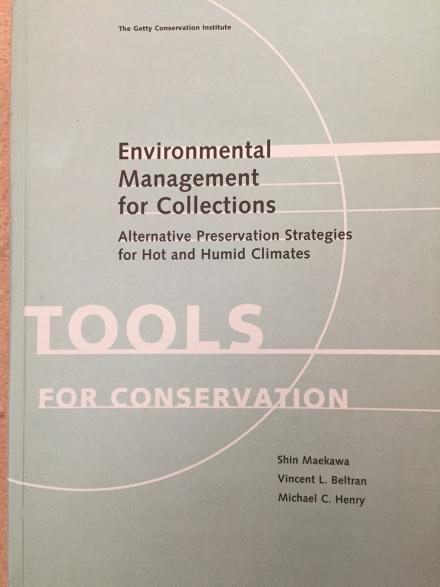Book review: Environmental Management for Collections Alternate Preservation Strategies for Hot and Humid Climates
Submitted by bborghese on

Shin Maekawa, Vincent L.Beltran, Michael C. Henry, Getty Conservation Institute, 2015, Series Tools for Conservation, 344 pages, paperback, ISBN 978-1-60606-434-4
Environmental management of collections is an area where IIC is particularly active, with various recent issues of Studies in Conservation dedicated to the theme, and culminating in the joint IIC/ICOM CC Declaration on Environmental Guidelines which came out of debate at the ICOM CC Melbourne 2014 Conference and the IIC Hong Kong 2014 Congress.
The science on which these debates are based has been steadily accumulating, progressively putting to rest the criticism that too much of the data is experimental rather than experiential. A key player in this space has been the Getty Conservation Institute (GCI), most recently with their Managing Collection Environments project, which is a work in progress. But from its earliest days GCI has focused on the management of museum environments as a core research activity.
Environmental management for Collections Alternative Preservation Strategies for Hot and Humid Climates has been written by three distinguished specialists in this area Shin Maekawa, Vincent L. Beltran and Michael C. Henry, all of whom have been investigating this issue for over two decades. The nature of the museum sector, and, as a subset of that, the conservation sector, is that the predominant activity, and thus the literature it generates, is European and North American. As the climate in these areas of the world are mostly temperate, the issue of appropriate environments for collections exhibition and storage has concentrated on such climates and the issues they raise. The work particularly of Danish and Canadian conservation scientists has drilled into this further as it relates to cool climates and the benefits which come from low temperature storage.
So this book is a very welcome addition to the currently sparse technical literature concentrating on environments for those collections held in hot and humid climates. Broadly speaking these are tropical climates which cover vast swathes of Central and South America, Africa, Asia and the Pacific, but the issues also extend to marine climate zones where there are seasonally hot and humid conditions, which includes a quarter of continental United States. Dominant collection issues in these regions with high humidity are microbial attack, increased insect activity and the mechanical and chemical stresses that high RH causes.
The book is divided into two parts, the first a very detailed examination of the issues and potential solutions and the second part a series of 7 case studies.
The first part begins by establishing the climate zones being discussed and then details the particular risks these climates present for collection care and for buildings in which they are housed. Chapters cover how to balance the risks of environmental management with conservation priorities and then overlays this with the need to establish the needs and comfort of occupants, and work through the potential conflict between collection conservation and thermal comfort. Chapters then cover the technical aspects of psychrometric, non-mechanical and mechanical strategies for environmental management, before concluding the first part with a useful Five Step process for the design and implementation of a successful environmental management strategy.
The second part then applies this five step process to 7 projects in China, Brazil, Spain and Georgia, USA. This is comprehensively detailed, and overlays each with highly valuable information on the energy metrics arising from the solution and the lessons learned. This is theory being put into practice in an accessible way, providing vital experiential data.
There is no doubt therefore that this book is a major and valuable addition to the environmental management for collections literature. Reviewing it, I was challenged once again as a conservator to question where we sit in this complex space. Conservators are often being asked to comment on issues for which we have minimal training. We know the results that poor or non-existent environmental management strategies can cause to the collections we care for, and we can provide guidelines for appropriate and sustainable environments. But creating those environments is largely beyond us. Our value comes from being able to dialogue with the building managers, architects and mechanical engineers on what the mechanical or non-mechanical solutions might be, and the compromises that can or cannot be made in delivering these.
This book demonstrates why we need a seat at the table, and provides conservators with much needed awareness around both the issues and the potential solutions to environmental management in these climes.
About the author: Julian Bickersteth is IIC Vice-president and Director of Communications. He graduated from Oxford University in 1979 with a degree in Theology before training as a furniture conservator at West Dean College, UK. After working as an independent conservator in London he was appointed first furniture conservator at the Powerhouse Museum, Sydney in 1983. In 1987 he established International Conservation Services (ICS) where is currently Managing Director.